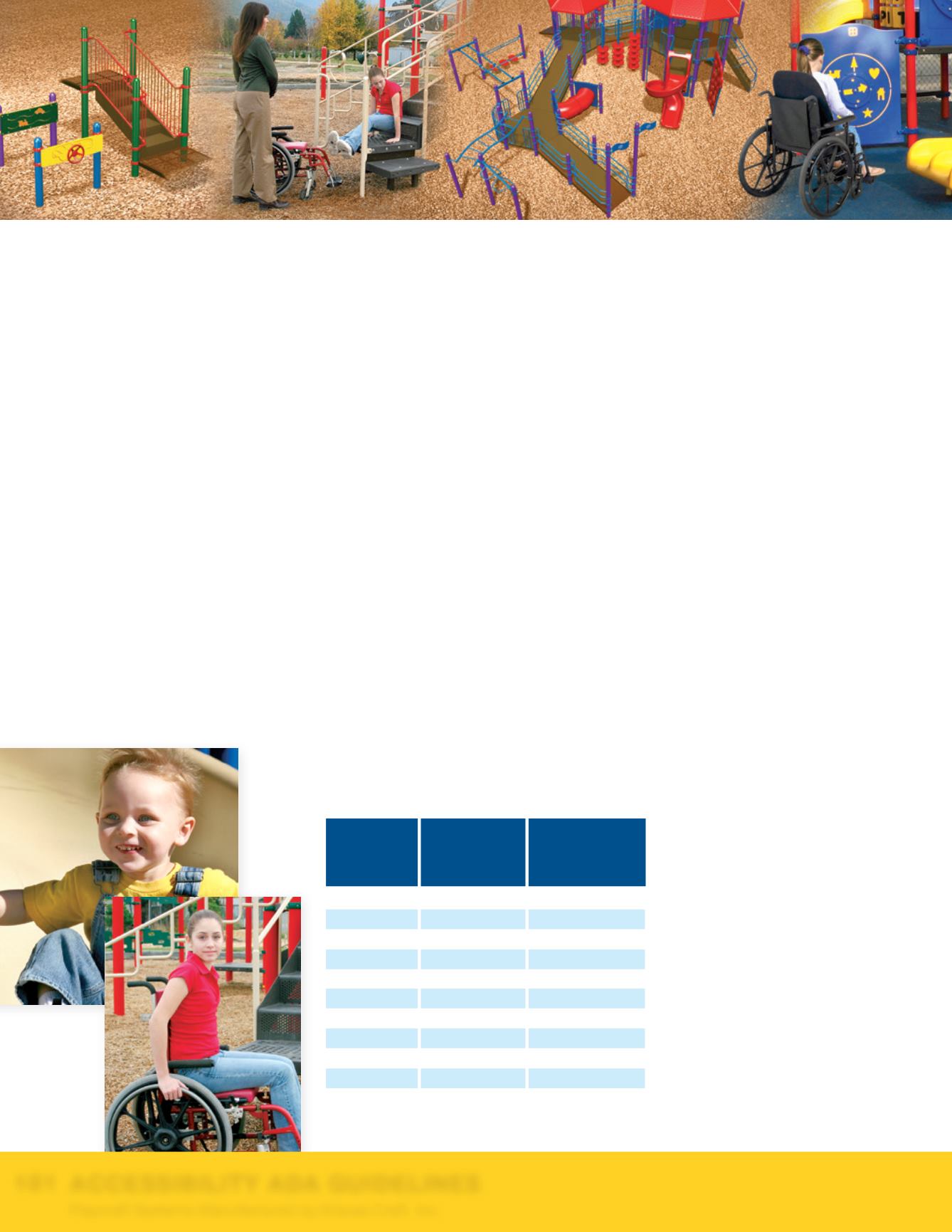

Playcraft Systems Manufactured by Krauss Craft, Inc.
181
* Plus 1 for each additional 3 elevated events over 25 or fraction thereof.
Accessible Ground-Level Events
Referenced from Table 240.2.1.2
of the ADAAG on February 2012.
Note:
If at least 50% of the elevated play
events are connected by a ramp, and if
at least 3 of the elevated events are of
different types, this chart does not apply.
For Example:
If a play area has 12
elevated play events, at least 6 must be
accessible. In addition, 4 ground-level
play events are needed, 3 of which must
be different kinds of activities.
For a complete copy of the U.S.
Architectural and Transportation Barriers
Compliance Board’s guidelines, call
1-800-872-2253 or visit
www.access-board.gov.
The following chart illustrates the ADA Requirement
for the Number and Types of Ground Level Play
Components Required to be on Accessible Routes.
Boundary Free Designs
We approach each playground design with all kids in mind. Our designers create optimal layouts for ground level play components
to foster interaction and socialization among children of all ages and abilities. From the early design stages to the finish, we strive to
offer the very best accessible playgrounds in the industry!
The U.S. Access Board has developed ADA accessibility guidelines ensuring that children with disabilities will have access to
playgrounds and play events where they can be free to play and interact with other children. The following summary outlines
the Americans with Disabilities Act Accessibility Guidelines (ADAAG) and how they apply to playground equipment for public use.
Accessible Routes to the Play Areas
Accessible routes provide children who use wheelchairs or other mobility devices the opportunity to access play components. It
is important to create a path using accessible surfacing to connect the play area with other accessible areas such as sidewalks,
buildings, parking lots, etc. Accessible routes should coincide with the general circulation path used within the play area. Careful
placement and consideration of the layout of accessible routes will enhance the opportunities of children of all ages and abilities to
socialize and interact.
Ground Level Play Events
A ground level play event is a play event which is approached and exited at ground level. Examples of ground level play components
include panels, spring activities, swings, diggers, and stand alone slides. When distinguishing between the different types of ground
level play events, one should consider the general experience provided (rocking, swinging, climbing, spinning, sliding, etc.). Ground
level events need to be placed along an accessible route or over accessible surfacing.
Must Provide Access to Half of the Elevated Events
Smaller play structures must use transfer stations or equivalent means of access to 50% of the elevated events. Larger play structures
with 20 or more elevated events must provide ramps for wheelchair access to at least 25% of the elevated events in addition to
transfer or equivalent access to 25% of the elevated events.
Transfer Stations
A transfer station is a ground level transfer point accompanied by components with rises of no more than 8” (20.3cm), allowing for
accessible change in elevation on the play systems. It is important to note that if a slide or climber can be reached by transfer or
wheelchair, it must exit over an accessible surface to be fully accessible.
Number of Elevated
Play Components
Provided
Minimum Number
of Ground Level
Play Components
Required to be on an
Accessible Route
Minimum Number of
Different Types of Ground
Level Play Components
Required to be on an
Accessible Route
1
N/A
N/A
2 - 4
1
1
5 - 7
2
2
8 - 10
3
3
11 - 13
4
3
14 - 16
5
3
17 - 19
6
3
20 - 22
7
4
23 - 25
8
4
more than 25
8*
5
ACCESSIBILITY ADA GUIDELINES

















